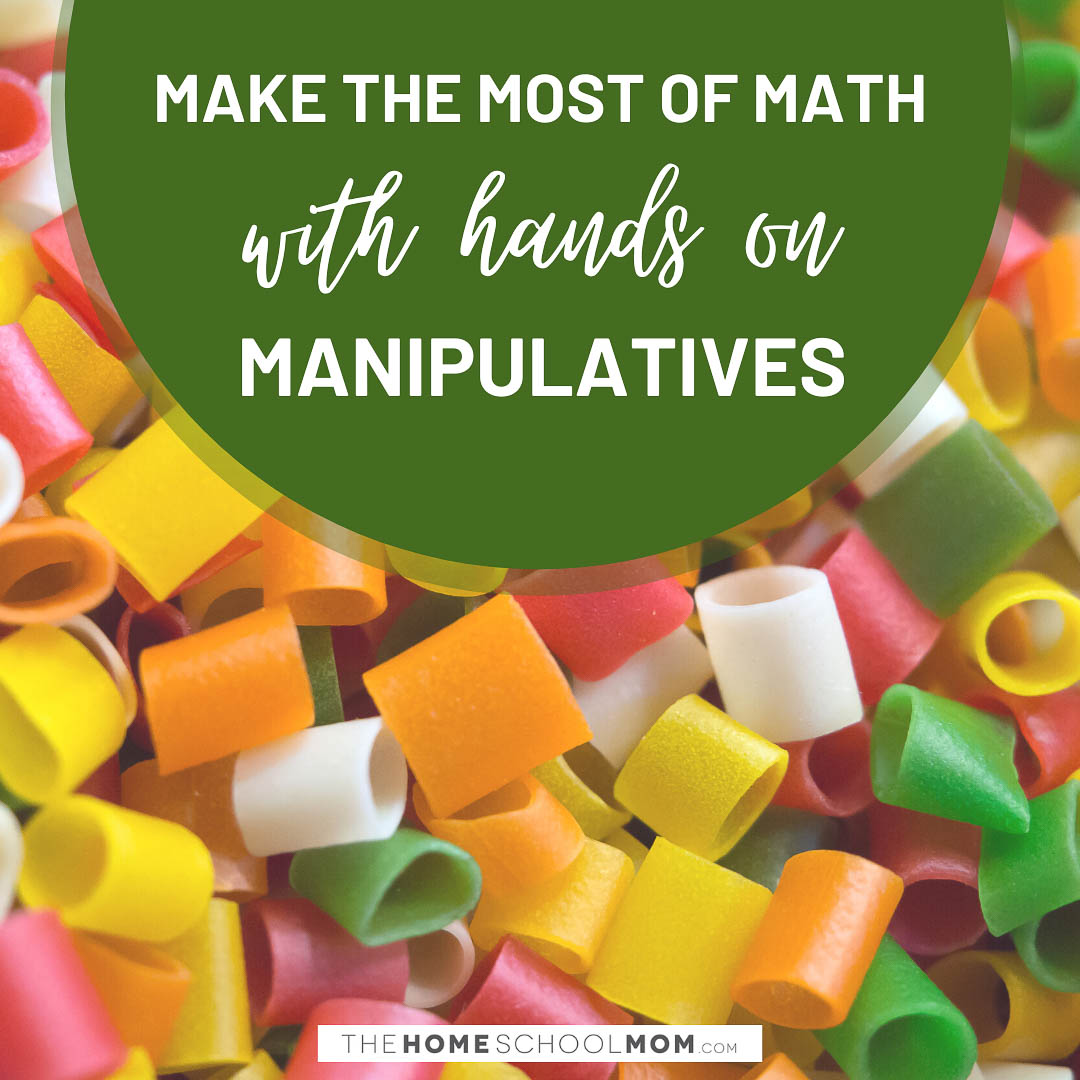In Instead of Curriculum: Math Games (Fun Multiplication Practice!), I described some of the games I played with my sons to help them learn and practice their multiplication facts. Today, I'll tell about some of the hands-on tools homeschoolers use to help their kids make sense of the basic concept of multiplication as well as related multiplication facts.

Cuisenaire Rods
These colorful rods are frequently used with Miquon Math curriculum. Each color corresponds with a specific length in centimeters (cm), from 1 - 10 cm. I kept these in easy reach when the boys were young, and we frequently played with them, building with them and tracing them onto paper. The thing is, five of the 2 cm rods are exactly the same length as a 10 cm rod. Five of the 3 cm rods are exactly the same length as one 10 cm and one 5 cm rod lined up end to end. And so on. The kids made discovery-based conclusions about multiplication facts through their play.
Cuisenaire rods come in wood and plastic. I love the feel and sturdiness of wood sets, and they are easier on bare feet. Today you can also find interlocking plastic Cuisenaire rods, magnetic Cuisenaire rods, and "ants-on-a-log" Cuisenaire rods, as well as idea books, guide books, one-centimeter graph paper, and other materials that can be used with Cuisenaire rods.
Multiplication Wrap-ups
How often do you see an educational item at Amazon with this many five star reviews? Multiplication Wrap-Ups (affiliate link) are grooved plastic cards with threads that learners use to trace from a multiplication fact to its solution. There is a separate card for each math fact family. You can check your answer by flipping the card over to see if the way you arranged the thread indicating answers matches the guide on the back.
Multiplication Wrap-ups sound complicated and hard to imagine, but they were something the kids picked up on with little or no instruction from me and practiced on their own.
Multiplication wrap-ups are more tactile than traditional flash cards and stood up to use by three different kids widely spaced apart. This was one of those homeschool purchases I felt good about years later.
Natural manipulatives
I kept small baskets and glass jars in my kitchen filled with natural "countable" objects that could be used as counters. These included dried beans, colored pastas, river pebbles, and sea shells. When I wanted to illustrate a math concept, we had a ready supply of objects that could be handled, counted, grouped, regrouped, and divided. There is no clearer illustration of the conceptual side of math facts than having a child count out five sets of lovely gray-pink river rocks, with three rocks in each set. "Fifteen!" he'll say, as understanding dawns. I've seen other interesting manipulatives used in the homes I've visited -- empty thread spools, old buttons, and bolts.
Money
One of my memorable homeschooling evaluations this past summer was with a charming first grader who wanted to show me how she had learned the basic concepts of multiplication using money. She grouped four quarters to make a dollar. She counted dimes "by ten" to equal both one hundred pennies and a dollar. She grouped five nickels and counted them "by fives" to equal a dime, then a quarter. Then she used nickels to create equivalencies for a half dollar and a dollar. Four five dollar bills equal a twenty dollar bill, she demonstrated.
An interesting thing about her learning was that, with guidance from her mom, she was instinctively building other number sense at the same time. She proudly proclaimed that a dime was both "one tenth" of a dollar and "ten percent" of a dollar.
Her use of money is not only a great example of the effectiveness of hands-on math manipulatives, but also of real life providing resources for learning academic skills. Her parents created additional interest in this activity by encouraging her to earn, save, and budget money for charity and small purchases.
Hands-on Learning
Many math curricula include a hands-on aspect for learning multiplication. You can supplement your curriculum with these ideas or use them instead of curriculum during the early years.
I know many of you are homeschooling kindergarten and elementary children with babies and toddlers around. Please keep in mind that most math manipulatives are also choking hazards. Seek a balance between keeping them out of reach of your littles while keeping them handy so you can integrate the manipulatives into daily life.





 A popular speaker at homeschooling conferences, business groups, and parents’ groups, Jeanne Potts Faulconer homeschooled her three sons in North Carolina, Mississippi, and Virginia for twenty years. Holding her Master of Arts degree in Communication, Jeanne conducted portfolio evaluations for Virginia homeschoolers for evidence of progress for many years. Jeanne is a former college faculty member, former editor for several publications, news correspondent for WCVE, and former director of Brave Learner Home. She is the contributing editor for TheHomeSchoolMom newsletter and writes the popular Ask Jeanne column addressing homeschool parents' questions here at TheHomeSchoolMom.
A popular speaker at homeschooling conferences, business groups, and parents’ groups, Jeanne Potts Faulconer homeschooled her three sons in North Carolina, Mississippi, and Virginia for twenty years. Holding her Master of Arts degree in Communication, Jeanne conducted portfolio evaluations for Virginia homeschoolers for evidence of progress for many years. Jeanne is a former college faculty member, former editor for several publications, news correspondent for WCVE, and former director of Brave Learner Home. She is the contributing editor for TheHomeSchoolMom newsletter and writes the popular Ask Jeanne column addressing homeschool parents' questions here at TheHomeSchoolMom.
These are the good hands-on tools for education to learn multiplication. Games are one of the best ways to teach multiplication to the homeschoolers. As a homeschool parent, I am also using https://logicroots.com/math-games/say-cheese-cafe/ multiplication game for my child. He loves this game and every now and then we play this game to practice multiplication table.